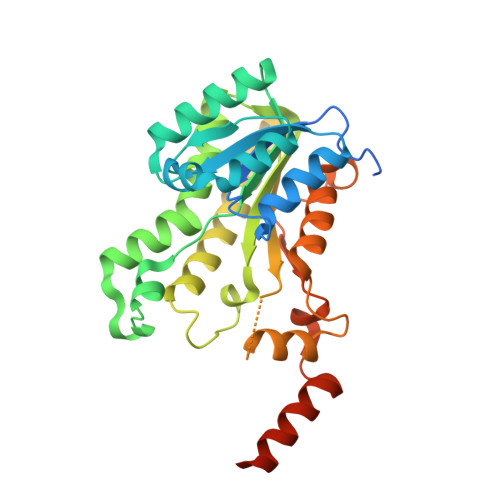The genome of a Bacteroidetes inhabitant of the human gut encodes a structurally distinct enoyl-acyl carrier protein reductase (FabI).
Radka, C.D., Frank, M.W., Yao, J., Seetharaman, J., Miller, D.J., Rock, C.O.(2020) J Biol Chem 295: 7635-7652
- PubMed: 32317282
- DOI: https://doi.org/10.1074/jbc.RA120.013336
- Primary Citation of Related Structures:
6VLX, 6VLY - PubMed Abstract:
Enoyl-acyl carrier protein reductase (FabI) catalyzes a rate-controlling step in bacterial fatty-acid synthesis and is a target for antibacterial drug development. A phylogenetic analysis shows that FabIs fall into four divergent clades. Members of clades 1-3 have been structurally and biochemically characterized, but the fourth clade, found in members of phylum Bacteroidetes, is uncharacterized. Here, we identified the unique structure and conformational changes that distinguish clade 4 FabIs. Alistipes finegoldii is a prototypical Bacteroidetes inhabitant of the gut microbiome. We found that A. finegoldii FabI ( Af FabI) displays cooperative kinetics and uses NADH as a cofactor, and its crystal structure at 1.72 Å resolution showed that it adopts a Rossmann fold as do other characterized FabIs. It also disclosed a carboxyl-terminal extension that forms a helix-helix interaction that links the protomers as a unique feature of Af FabI. An A f FabI·NADH crystal structure at 1.86 Å resolution revealed that this feature undergoes a large conformational change to participate in covering the NADH-binding pocket and establishing the water channels that connect the active site to the central water well. Progressive deletion of these interactions led to catalytically compromised proteins that fail to bind NADH. This unique conformational change imparted a distinct shape to the Af FabI active site that renders it refractory to a FabI drug that targets clade 1 and 3 pathogens. We conclude that the clade 4 FabI, found in the Bacteroidetes inhabitants of the gut, have several structural features and conformational transitions that distinguish them from other bacterial FabIs.
Organizational Affiliation:
Department of Infectious Diseases, St. Jude Children's Research Hospital, Memphis, Tennessee 38105.














